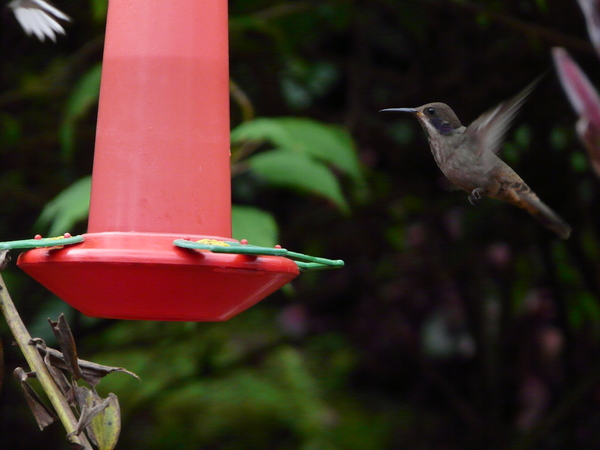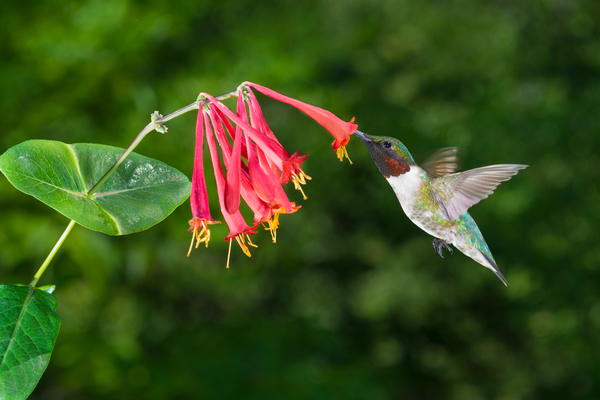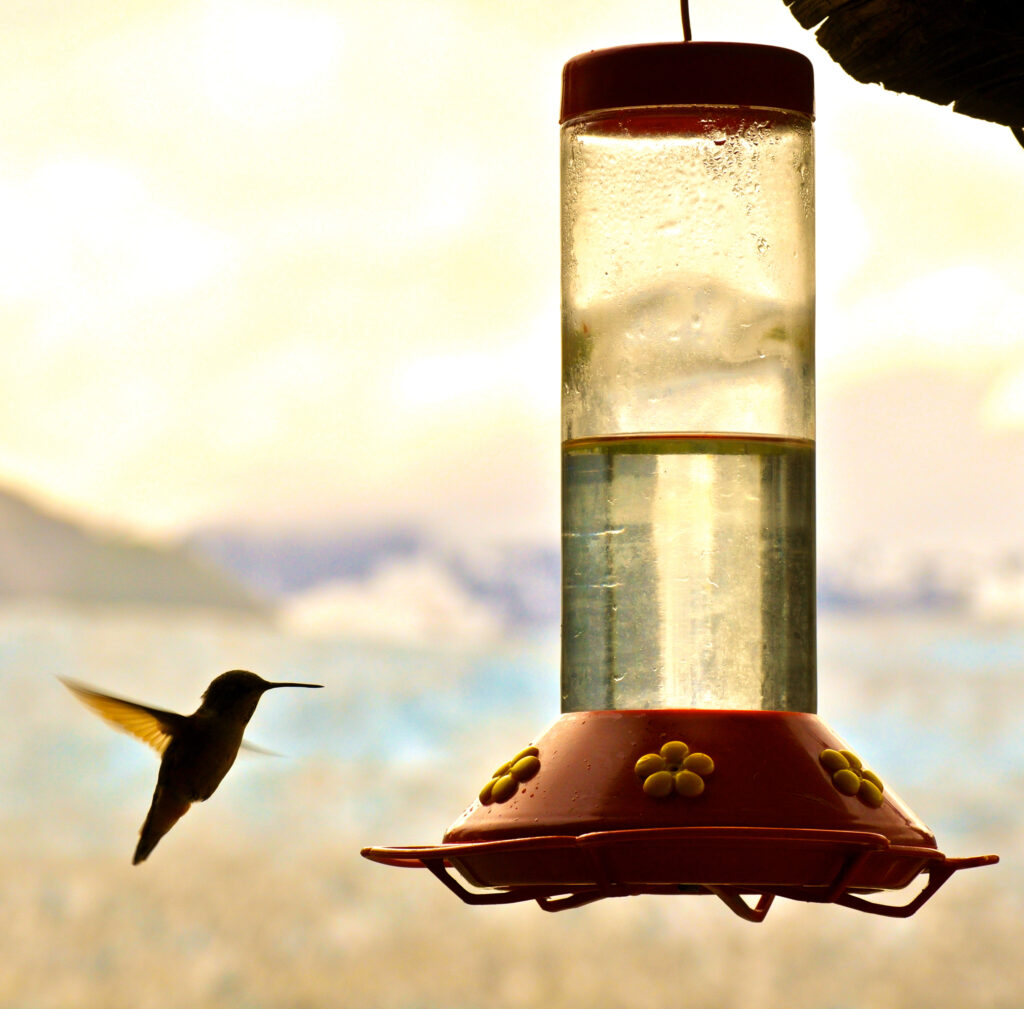Have you ever wished to bring the mesmerizing beauty of hummingbirds to your own backyard? I know I have.
In this article, I’ll share straightforward tips and tricks I’ve learned along the way to help you create an irresistible haven for these enchanting creatures at your feeder.
Let’s embark on a journey to discover how to attract hummingbirds and witness their delightful presence up close.
How to Attract Hummingbirds to Feeder?
1. Brighten Up the Place
Bright hues, especially red and pink, attract hummingbirds.
If you don’t even have a variety of flowers to draw their attention organically use ribbon instead.
Hummingbirds might be attracted for the first time by tying crimson ribbons about your yard.
The ribbons appear to be a line of flowers blooming along a vine from afar. Birds will notice a vividly painted feeder as they get closer to exploring the vibrant colors.
This is a crucial strategy for attracting hummingbirds to a new feeder.
These are the Best Plants to Attract Hummingbirds.
2. Attract Using Hummingbird or Nectar Feeders

Another great technique to keep a visiting hummingbird interested is to hang hummingbird feeders.
Keeping a feeder clean and filled costs little money and takes little work.
Hummingbird feeders rather than plastic seed feeders might be a charming feature of your garden.
If you are looking for a Hummingbird Feeder Recommendation, check out Hummingbird Feeders on Kingsyard.
Hummingbirds have great eyesight while having a poor sense of smell.
Bright colors attract their attention because they reflect the flowers that provide them with nectar.
The feeder should be brightly colored and put in an open, conspicuous area to make it easily visible.
Hummingbirds are possessive, so don’t let them share your feeder with other hummingbirds or species of birds.
If you have any additional feeders, they should be set back a bit.
The comfort of the hummingbirds will be ensured via separate feeding stations.
You could make a buddy who comes year after year if there isn’t any other bird activity around.
3. Use the Best Nectar Recipe
Four parts water to one part sugar is the ideal ratio.
Make certain you’re using only refined white sugar.
Brown sugars may contain molasses and food coloring which is detrimental to hummingbirds’ health.
At all costs, artificial sweeteners should be avoided.
Food coloring should not be used to color the nectar.
The birds may have gastrointestinal distress as a result of this.
If you want to add some color to the outside of the nectar bottle use glass paint.
Make sure the four-to-one ratio is right as well.
Using greater sugar content might stress the liver and kidneys of the bird.
This is the Hummingbird Nectar that I use and I highly recommend it to you. Check it out on Amazon.
4. Use a Protein Feeder
Insects are a significant source of nutrition for hummingbirds in addition to nectar.
Hummingbirds rely on the carbohydrates in plant nectar to survive, but they also require protein.
The use of banana peels as a source of protein is a novel idea.
Hummingbirds aren’t attracted to the peels themselves, but insects are.
These insects will offer nectar feeders with important nutritional supplements and guarantee that all of the food categories that hummingbirds require are available.
5. Planting a Flower Garden

Because of their rapid metabolism, hummingbirds have a high demand for nectar.
Hummingbirds are always on the lookout for food sources to keep their energy levels up.
In fact, they may travel more than 20 kilometers each day between flowers.
Do you have the room, time, and green thumb to take care of flowers?
The most rewarding approach to attracting hummingbirds is to plant appropriate flower species in your yard.
These plants not only appear lovely, but they also give out enticing scents in your yard.
Hummingbirds will flock to a feeder if there is a well-kept flower bed nearby.
6. Keep the Hummingbird Water Feeder at all times

Almost all birds are meticulous, as though they are aware of the proverb cleanliness is next to godliness.
Bathing whether in dust or water is a vital component of a bird’s daily routine and hummingbirds are no exception.
Hummingbirds aren’t as obnoxious as other birds when it comes to splashing about in a bath.
They would rather shower.
In the rain, hummingbirds are often observed extending their wings to get a good soak.
Using a mister attachment on your garden hose is a fantastic way to give hummingbirds a shower.
If you really have a hummingbird in your backyard a misting spray will round out the five-star rating.
Watching the birds fly back and forth in the mist until they’re totally wet is entertaining.
They will frequently sit for a few moments when soaked.
Then they’ll give a brisk shake and vanish on their never-ending quest for more food.
Hummingbirds may be fussy when it comes to drinking water.
Because of their tiny size, contaminants in their drinking water can have a major impact on hummingbirds.
If they avoid the birdbath entirely, don’t take it personally.
Hummingbirds prefer to sip the dew that forms on plants early in the morning.
Dew has more nitrogen and potassium than most natural water sources.
Is your current
Hummingbird’s Favorite Habitat
Hummingbirds plant deep roots.
They will return every year once they have found a habitat that meets their demands.
Hummingbird moms will educate their offspring to frequent your feeder, despite the fact that they only survive for three to five years.
Hummingbirds match the movement of the bloom as it blows in the wind while hovering and sipping from it.
Then they scurry through the undergrowth’s thick stalks.
With their speed and agility, you’d think they could nearly avoid raindrops in a downpour.
Male and female hummingbirds are not faithful to their mates, despite their commitment to a fruitful area.
Even throughout the breeding season, men and females will mate with many partners.
This implies that eggs from the same nest do not always have the same father.
Takedown the spider webs.
Hummingbirds prize spider webs as a nesting material, which may seem like a nightmare to arachnophobia.
Hummingbirds require spider webs to insulate their nests, thus removing them is a waste of time.
One thing to remember is that hummingbirds are highly territorial in their territory.
They also have trouble distinguishing between reflections and the real environment.
As a result, a territorial man might exhaust himself and perhaps die fighting his own mirror.
If you are wondering Why Won’t Hummingbirds Come to My Feeder? Then check this article that I have linked to.
Final Words
In conclusion, the allure of attracting hummingbirds to your feeder is not just about creating a visual spectacle, but about fostering a connection with the wonders of nature.
By following these practical steps and making a few adjustments, you’ve embarked on a journey of discovery and patience.
As you witness these tiny marvels gracing your feeder, remember that each sip they take is a testament to your dedication to providing a welcoming environment.
With persistence, attention to detail, and a touch of awe, you’ve set the stage for an ongoing ballet of colors and flight in your very own backyard.
So, let the hum of their wings and the vibrant beauty they bring be a reminder of the simple joys that nature graciously offers.
FAQ
What's the right location for my feeder?
Hummingbirds prefer feeders placed in areas with partial shade. Avoid direct sunlight, as it can cause the nectar to spoil quickly. Also, choose a location where you can easily observe the feeder’s activity.
What's the best nectar recipe for hummingbirds?
Create nectar by mixing four parts water with one part white granulated sugar. Boil the water to remove impurities and dissolve the sugar. Let it cool before filling your feeder.
How often should I change the nectar?
Change the nectar every 3-5 days, even if it’s not empty, to prevent spoilage and bacterial growth. In warmer weather, you might need to change it more frequently.
Are there certain flowers that attract hummingbirds?
Absolutely. Hummingbirds are drawn to brightly colored, tubular flowers. Consider planting red, orange, and pink flowers such as trumpet vine, salvia, and bee balm in your garden to attract them naturally.
Do I need multiple feeders?
Having multiple feeders can reduce competition among hummingbirds and provide more access to food. Spread them out in different areas of your yard to accommodate more visitors.
Last Updated on September 4, 2023 by Lily Aldrin

